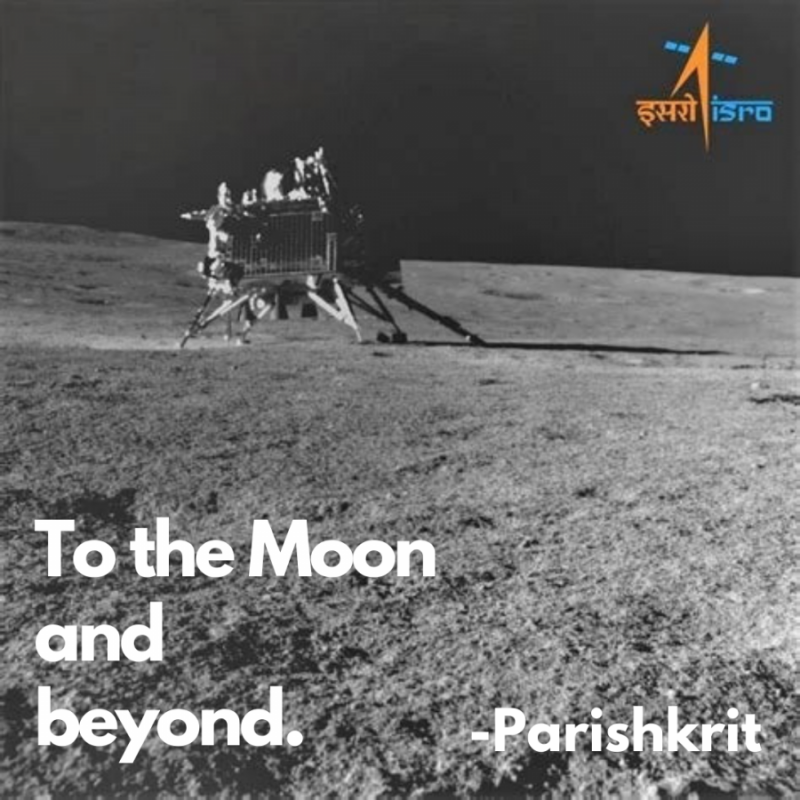To the Moon and beyond
By Parishkrit, BMS’25
On July 14th, when the LVM3 launch vehicle took off from the Satish Dhawan Space Center in Sriharikota, it wasn’t only carrying the lander module of Chandrayaan-3, but also the cosmic ambitions of our nation and its space entity punching above their weight. Chandrayaan-3 was the third such ambitious mission of ISRO which seeks to further explore the earth’s only natural satellite. After the grand success of Chandrayaan-1 which discovered the presence of water on the moon, and the partial success of Chandrayaan-2 in 2019, this was the third iteration of the moon mission, and this time the aim was to land successfully on the south pole of the moon. No other space organisation has been able to achieve this feat successfully till now. Not CNSA (China National Space Administration), not ROSCOSMOS (Space Agency of Russia), not even NASA (National Aeronautics and Space Administration). India failed to achieve a soft landing with Chandrayaan-2 in 2019, but it was able to successfully deploy the orbiter which is still fully functional and is providing valuable data and insights back to ISRO.
In 2014, India successfully completed its first Mars mission and deployed an orbiter around Mars. It became the first nation to accomplish this feat in the very first attempt. The Mars orbiter worked for 7 years after its deployment which was way beyond its expected life span of 6 months. In September 2014, the New York Times published a cartoon depicting a farmer and a bull knocking on the door of the “elite space club” a satire aimed at India’s Mars mission. Nice cartoon dare I say.
Almost 9 years later, on August 23rd 2023, instead of knocking on the door, India demolished that door and created an “Elite Space Club” for itself. Ladies and gentlemen, India had successfully achieved soft landing on the south pole of the moon. It became the first nation to do so, and only the fourth nation to successfully land on the Lunar surface. It became a much bigger accomplishment especially after considering that Russian moon lander Luna-25 crashed on the surface of the moon in its attempt to execute a soft landing a few days ago. The whole world rejoiced and congratulated India and ISRO for this monumental feat. ‘India is on the Moon’ reported the New York Times, but sadly there was no cartoon this time around.
While it’s hard to wrap our heads around the remarkable success ISRO has achieved in such a short time frame, the brilliant minds at ISRO aren’t planning to slow down any time soon. After a successful Mars mission in 2014, making history with Chandrayaan-3, what frontier of space do they choose to take on now you ask?
Ladies and Gentlemen, the crown jewel of our solar system, the Sun. Yes you heard it right. Aditya-L1 is the first solar mission of ISRO which aims to study the sun and the solar atmosphere. Aditya means ‘the Sun’ in Hindi. The L1 in the name refers to the first Lagrangian point of the solar system. What happens when both sides pull with equal force in a game of tug of war? The rope becomes static. It neither goes rightwards nor leftwards, it just stays there. Similarly, L1 is a ‘position’ in space where the gravitational pull of the sun and earth becomes equal and nullifies each other. Now, if you place a satellite at the L1 position, it stays there statically. There are 5 Lagrangian points in the solar system, L1 being only 1.5 million km away from earth. Amusing! Isn’t it? Well that’s cosmos for you.
Aditya-L1 will stay put at L1 and watch the sun through various advanced imaging equipment and send valuable data back to the earth. It will help us understand various phenomena ongoing in solar astronomy and help us deepen our understanding of the solar system.
ISRO is also working on India’s first human space flight mission. By 2025, they aim to become the only fourth entity to independently send humans into space. Further, they also plan to send an orbiter to earth’s twin Venus named Shukrayaan. Mangalyaan-2, the second Mars mission is also on the cards.
The achievements of ISRO in the last two decades are beyond extraordinary. Its significance becomes even more astounding and praiseworthy when compared to the budget of the American Space Agency NASA. The difference is nearly 20 billion dollars! You must have come across many articles with flashy headlines telling you about a particular space agency successfully deploying a satellite in the orbit of Mars for less than the budget of many Hollywood science fiction movies. They surely were talking about ISRO. Maybe the New York Times should make a cartoon about that.
There is a substratum of people who question the worth of such exploratory missions and advocate for the resource allocation for solving various problems back at home. I want them to know that in the last five years ISRO made 1000 crores only by launching satellites of various nations. So, even that argument amounts to nothing, because space exploration is more than just a show-off of technological superiority. It has the potential to change the outlook of an entire nation and inspire upcoming generations of kids to pursue advanced research in such fields to unravel the mysteries of the universe instead of just climbing up the “corporate ladder”.
And if you are amazed by the achievements of ISRO then I would ask you to keep an eye on this space agency, because it is going to steal your attention on various occasions in the coming days, months, years, decades and beyond.




Comments